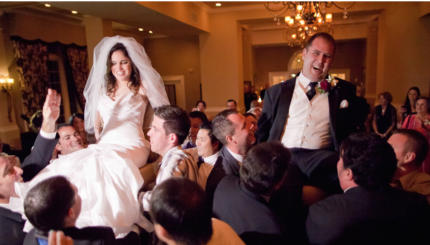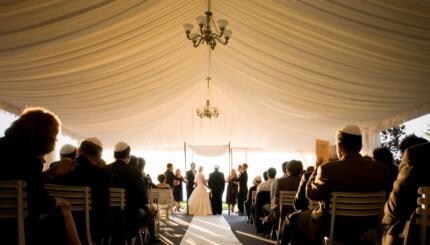The Jewish wedding ceremony ends with a famous bang. Stomping on a glass is one of the best-known features of Jewish weddings. Traditionally, the groom did the deed; today the couple often share the honor/pleasure, smashing one or two napkin-wrapped glasses.
Few Jewish symbols have a single explanation, and this one is downright kaleidoscopic. The custom dates back to the writing of the Talmud:
Mar bar Rabina made a marriage feast for his son. He observed that the rabbis present were very gay. So he seized an expensive goblet worth 400 zuzim and broke it before them. Thus he made them sober. (Berakhot 5:2 )
In other words, where there is rejoicing, there should be trembling.
By the Middle Ages, synagogue facades in Germany were inlaid with a special stone for the express purpose of smashing a glass at the end of weddings. However, its interpretation changed somewhat by the 14th century, when, according to Maurice Lamm’s The Jewish Way in Love and Marriage, it was viewed as a reminder of the destruction of the Temple in Jerusalem. Either way, the lesson is that even at the height of personal joy, we recall the pain and losses suffered by the Jewish people and remember a world in need of healing.
With your help, My Jewish Learning can provide endless opportunities for learning, connection and discovery.
The fragility of glass suggests the frailty of human relationships. Since even the strongest love is subject to disintegration, the glass is broken as a kind of incantation: “As this glass shatters, so may our marriage never break.”
Loud noises are a time-honored method for frightening and appeasing demons that are attracted to beautiful and fortunate people, such as the happy couple beneath the huppah (also commonly spelled chuppah).
Marriage is a covenant, which in Judaism is made by breaking or cutting something. At Sinai, tablets were broken; at a wedding, broken glass “cuts” the covenant.
Breaking the glass also has sexual connotations, as it prefigures the release of sexual union, which is not only permitted to married couples but also required of them. For centuries breaking the glass implicitly symbolized breaking the hymen, which is why it was so important that the groom succeed.
The crash of glass ends the hush of mythic time under the huppah, and the world rushes in. Everyone exhales, claps and shouts, “Mazel tov!” The celebration begins.
You can break any kind of glass: old, new, borrowed, or blue. Whatever you choose, it should be well wrapped to prevent injury. A heavy cloth napkin is standard, but you can buy a satin pouch or a velvet bag. (Some artisans fashion mementoes out of the shards.) While a lightbulb wrapped in a linen napkin might make a louder pop, it seems like a poor stand-in for such a rich and ancient symbol.
Excerpted with permission from The Jewish Wedding Now (Simon & Schuster)
Are you planning a Jewish wedding? Let us help out! Sign up for Breaking the Glass, an email series that will help guide you to the wedding that’s right for you!
chuppah
Pronounced: KHOOP-uh or khoo-PAH, Origin: Hebrew, canopy under which a Jewish wedding ceremony takes place.
Talmud
Pronounced: TALL-mud, Origin: Hebrew, the set of teachings and commentaries on the Torah that form the basis for Jewish law. Comprised of the Mishnah and the Gemara, it contains the opinions of thousands of rabbis from different periods in Jewish history.



